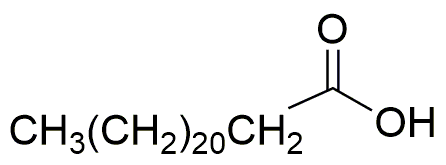Tricosanoic acid is widely utilized in research focused on:
- Cosmetic Formulations: This fatty acid is used in skin care products for its emollient properties, helping to moisturize and soften the skin.
- Food Industry: It serves as a food additive, enhancing the texture and stability of various food products, particularly in emulsions.
- Biodegradable Plastics: Tricosanoic acid is incorporated into the production of biodegradable polymers, contributing to environmentally friendly packaging solutions.
- Pharmaceuticals: It is used in drug formulations as a surfactant, improving the solubility and bioavailability of active ingredients.
- Lubricants: The compound is employed in the formulation of high-performance lubricants, offering excellent thermal stability and reducing friction in industrial applications.
General Information
Properties
Safety and Regulations
Applications
Tricosanoic acid is widely utilized in research focused on:
- Cosmetic Formulations: This fatty acid is used in skin care products for its emollient properties, helping to moisturize and soften the skin.
- Food Industry: It serves as a food additive, enhancing the texture and stability of various food products, particularly in emulsions.
- Biodegradable Plastics: Tricosanoic acid is incorporated into the production of biodegradable polymers, contributing to environmentally friendly packaging solutions.
- Pharmaceuticals: It is used in drug formulations as a surfactant, improving the solubility and bioavailability of active ingredients.
- Lubricants: The compound is employed in the formulation of high-performance lubricants, offering excellent thermal stability and reducing friction in industrial applications.
Documents
Safety Data Sheets (SDS)
The SDS provides comprehensive safety information on handling, storage, and disposal of the product.
Product Specification (PS)
The PS provides a comprehensive breakdown of the product’s properties, including chemical composition, physical state, purity, and storage requirements. It also details acceptable quality ranges and the product's intended applications.
Certificates of Analysis (COA)
Search for Certificates of Analysis (COA) by entering the products Lot Number. Lot and Batch Numbers can be found on a product’s label following the words ‘Lot’ or ‘Batch’.
*Catalog Number
*Lot Number
Certificates Of Origin (COO)
This COO confirms the country where the product was manufactured, and also details the materials and components used in it and whether it is derived from natural, synthetic, or other specific sources. This certificate may be required for customs, trade, and regulatory compliance.
*Catalog Number
*Lot Number
Safety Data Sheets (SDS)
The SDS provides comprehensive safety information on handling, storage, and disposal of the product.
DownloadProduct Specification (PS)
The PS provides a comprehensive breakdown of the product’s properties, including chemical composition, physical state, purity, and storage requirements. It also details acceptable quality ranges and the product's intended applications.
DownloadCertificates of Analysis (COA)
Search for Certificates of Analysis (COA) by entering the products Lot Number. Lot and Batch Numbers can be found on a product’s label following the words ‘Lot’ or ‘Batch’.
*Catalog Number
*Lot Number
Certificates Of Origin (COO)
This COO confirms the country where the product was manufactured, and also details the materials and components used in it and whether it is derived from natural, synthetic, or other specific sources. This certificate may be required for customs, trade, and regulatory compliance.

